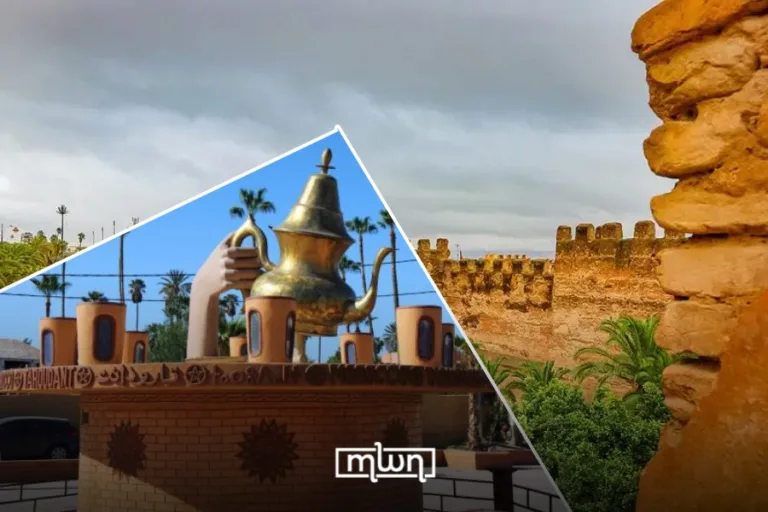Marrakech – In the days following Eid al-Adha, a unique and captivating sight unfolds on the streets of Agadir, Dcheira, Inezgane and other parts of the Souss and Anti-Atlas regions in Morocco.
Men, mostly adolescents and young adults, parade through the streets, their bodies adorned with sheep or goatskin, heads crowned with horns, and faces painted or masked.
This is the festival of Boujloud, also known as “Bilmawen” in the Amazigh language – a vibrant celebration of Moroccan heritage that has endured for generations.
Origins and meaning
Boujloud, which translates to “the father of skins” in Arabic, is a folk tradition with roots stretching back to pre-Islamic times in Morocco. The term Bilmawen in Amazigh means “the one with many faces.”
This ancient festival is observed annually in the Souss and western High Atlas regions, coinciding with the Islamic feast of Eid al-Adha.
While the exact origins are debated, some ethnologists suggest that Boujloud derives from ancient Amazigh rites celebrating the changing of seasons and the cycle of death and resurrection.
Others draw parallels to the Roman festival of Saturnalia. Regardless of its precise beginnings, Boujloud has evolved over time into a beloved cultural event that brings communities together in a spirit of joy and festivity.
The celebration
The Boujloud festivities typically commence on the second day of Eid al-Adha and continue for two to three days. Participants, predominantly young men, don the skins of sacrificed sheep or goats and roam the streets, accompanied by music and dance.
They playfully interact with the crowd, sometimes gently striking onlookers with animal limbs. Often the skin-wearing characters will ask for money in return for not getting hit. The money is usually collected and donated to local mosques or other Eid charities. The purpose is to spread laughter and merriment.
In some areas, such as Imintanout, the Boujloud procession incorporates elements from various local tribes and even historical Jewish influences, reflecting the rich tapestry of cultures that have shaped the region.
The festival often extends into the night, with street performances and gatherings in public squares.
Symbolism and interpretation
Anthropologists and researchers have offered diverse interpretations of the symbolism behind Boujloud. Some view it as a remnant of Amazigh pagan rituals, representing the cyclical nature of life, death, and rebirth. Others see connections to ancient rites of passage or celebrations of fertility.
Moroccan anthropologist Abdellah Hammoudi asserts that Boujloud is intrinsically tied to the sacrificial rituals of Eid al-Adha, serving as a means of engaging with the spiritual significance of the occasion. The wearing of animal skins is seen as a way of embodying the essence of the sacrificed creature.
Islamic perspective
While Boujloud is deeply ingrained in Moroccan culture, it is important to consider the Islamic perspective on this tradition.
Some local Islamic scholars have expressed strong reservations about the Boujloud festival, arguing that it is prohibited (haram) according to Islamic law (Sharia). They present several arguments to support their stance.
Firstly, they point out that there is no evidence that the Prophet Muhammad, his companions, or the early followers of Islam engaged in such practices.
Moreover, they claim that Boujloud is a Jewish and Christian custom, as the carnival is foreign to Islamic culture. They cite the sayings of the Prophet Muhammad, such as “Whoever imitates a people is one of them” and “Be different from the Jews and Christians,” to underscore their point.
Furthermore, these scholars argue that the festival encourages humans to imitate animals and wear their skins, which they believe degrades human dignity and lowers the status that Allah has bestowed upon humans by granting them intellect.
They also claim that wearing the skins of sacrificed animals disrespects the creatures that Allah created for the purpose of being slaughtered and enjoyed by humans.
Additionally, they express concerns about the singing and dancing that accompany Boujloud celebrations, as well as the practice of young men dressing in women’s clothing during the festival. These elements, they assert, provide further evidence that the festival is prohibited by Islamic law.
However, it is crucial to recognize that Boujloud has evolved over time, adapting to the Islamic context in which it exists.
Many participants and organizers make efforts to ensure that the celebration does not conflict with Islamic principles and that the focus remains on community, cultural heritage, and the spiritual significance of Eid al-Adha.
Evolving tradition
While Boujloud was once widely celebrated across Morocco, it has gradually faded in many areas.
However, the tradition remains strong in the Souss and Anti-Atlas regions, where it has adapted and evolved over time. Today, the festival often incorporates contemporary elements such as street art and giant dancing puppets, appealing to younger generations.
Efforts are underway to preserve and promote this important aspect of Moroccan cultural heritage.
Associations like the one in Imintanout work to ensure that Boujloud continues to thrive, introducing new roles and characters alongside the traditional “Boujloud” figure.
There are even aspirations to seek UNESCO recognition for the festival as part of the world’s intangible cultural heritage.
Boujloud, or Bilmawen, is a vibrant tapestry woven from the threads of Moroccan history, culture, and identity.
This enchanting tradition, with its mesmerizing masked figures and exuberant celebrations, acts as a conduit through time, connecting the present to the rich legacy of the past.
It is a living, breathing embodiment of the Amazigh spirit, a testament to the resilience and creativity of a people who have shaped the very essence of Morocco.
Read also: Amazigh Identity and Morocco’s Multicultural Challenge
















